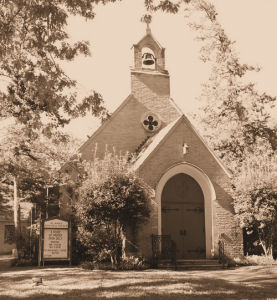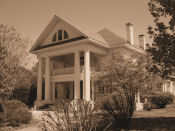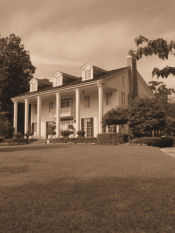 The boundaries of the Minden
Historic District encompass seventy-one buildings, all
but two
of which are residences. Contributing elements range in
date from c.1850 through 1942 and run the
gamut stylistically from Greek Revival to Spanish
Colonial Revival. The non-contributing element
The boundaries of the Minden
Historic District encompass seventy-one buildings, all
but two
of which are residences. Contributing elements range in
date from c.1850 through 1942 and run the
gamut stylistically from Greek Revival to Spanish
Colonial Revival. The non-contributing element
rate is twenty-one percent.
Located just north of the downtown, the nominated
district has a very irregular street plan
(see attached map). The most important buildings tend to
be concentrated on Broadway, which is
definitely the city's grand residential rue. Lots along
the boulevard are larger than elsewhere in the
district, and houses are often set well back from the
road. There are numerous mature trees, as is
true of the district as a whole. About one-third of the
historic houses on Broadway are two or
two-and-a-half stories. Interspersed among the larger,
more "upmarket" residences are smaller, less
pretentious houses. At the southern end of Broadway,
near the downtown, are the district's only two
non-residential buildings. One is the impressive Gothic
Revival Minden Presbyterian Church (1923),
and the other is a very historic looking Gothic
Episcopal church built in 1950.
For the most part, the other streets in the district
have small lots, with houses more densely
packed. As is the case with Broadway, landmarks are
scattered among more typical houses.
BREAKDOWN BY PERIODS
c.1850-1860 (4%)
Minden was founded in 1836 and incorporated in 1850,
although only three residences
survive from this early period. Two are two story Greek
Revival houses with narrow two story
porticoes reflecting the width of the central hall (1110
Broadway &
610 Lewisville Road). These represent a local variation in the
Greek Revival found within the region and nowhere else
in the state. The archetype appears as both
a plantation house and town residence. The third Greek
Revival house has had its original one story
porch across the front replaced, but its other early
character defining elements survive (413
East & West St.).
1861-1890 (1%)
There is only one house from this period, a two story
frame house with an elaborate Italianate
gallery and decorative work around the principal windows
and doors (1111
Broadway).
1891-1920 (24%)

Stylistically, this category includes the Queen Anne
Revival and the earliest wave of Colonial
Revival. There, of course, is also a transitional period
when a house might be Queen Anne in
massing and other detailing but have a Colonial Revival
gallery. Examples range from simple one
and one-and-a-half story galleried cottages to major
landmarks.
Landmarks from this period are:
(1)
McDonald House, 328 Lewisville (#55, N.R.), a
two-and-a-half story turreted
Queen Anne house.
(2)
614 Lewisville Road (#57), a Queen Anne/Colonial
Revival house whose porch
curves to form a turret-like projection.
(3)
101 Homer Road (#29), a large two-and-a-half story
Colonial Revival house
with a colossal Ionic portico.
(4)
Drake House, 1202 Broadway (#22, N.R.), a large two
story Colonial Revival
house with a colossal Tuscan pedimented portico.
1921-1942 (50%)

As is true of almost all historic districts in Louisiana
outside New Orleans, this category
accounts for the largest percentage of buildings. It
includes bungalows and two story houses built
along bungalow lines, later Colonial Revival houses, one
Georgian Revival house, a 1920s Gothic
Revival church, a 1920s Spanish Colonial Revival house,
and various cottages from the 1930s.
Some of the latter are unstyled, while others have
steeply pitched gables and prominent chimneys,
giving them an overall "Old English" look.
Major landmarks include:
(1)
Minden Presbyterian Church, 1001 Broadway (#1), a
large, elaborately styled
Gothic Revival building with German-looking
half-timbering motifs.
(2)
1113 Broadway (#11), a two story Colonial Revival
house with a one story
pedimented entrance porch.
(3)
1114 Broadway (#13), a two-and-a-half story Colonial
Revival house with a
Tuscan one story porch, modillions, and a handsome
Palladian motif dormer.
(4)
1300 Broadway (#24), a large Craftsman style house
with a massive pent
dormer and accented with rock-faced concrete blocks.
(5)
521 East/West
(#37, N.R.), a large two story Spanish
Colonial Revival house
with round arch windows and a spreading red tile roof
(originally a house, now the
Webster Parish Library).
(6)
411 East/West (#52), a two-and-a-half story Georgian
Revival residence with a
Palladian motif entrance and elegant dormers.
(7)
508 Fort (#61), a huge two-and-a-half story Colonial
Revival house with a
Mount Vernon style portico.
(8)
1302 Broadway (#26), a one-story cottage with a tile porch and iron railing.
Non-contributing Elements (21%)
There are fifteen non-contributing buildings in the
district, representing 21% of the building
stock. Many are small brick ranch houses. Five are two
story residences, but only one of these is
truly intrusive in character (1203
Broadway #21). The most interesting
non-contributing element is the previously
mentioned Gothic Revival
St. John's Episcopal Church
(#7), which although built in 1950,
contributes greatly to the district's character.
It should be noted that a twenty-one percent
non-contributing rate is fairly low for a
Louisiana district outside New Orleans. Very
importantly, the non-contributing buildings are
sprinkled
throughout the district and hence do not dominate in any
particular place.
Contributing Elements:
The district is significant as an outstanding collection
of historic residences, with contributing
elements ranging from c.1850 to 1942 (the fifty year
cutoff). While certain houses obviously make a
greater contribution to the significance than others,
any 50+ year old building that has not been
altered too badly should be considered a contributing
element.
The Minden Presbyterian Church obviously does not relate
to the district's status as an
outstanding collection of historic residences. It,
however, is easily individually eligible for the
Register
as one of the most elaborate and striking Gothic Revival
churches in the region.
Alterations to Contributing Elements:
Overall, the district's contributing elements are
surprisingly well preserved. There are a few
instances of vinyl or aluminum siding, sometimes
sensitively applied and sometimes not. In no case,
however, did the damage seem so severe that the building
should be considered non-contributing.
There are also a few instances of column replacement,
sometimes with imitation wrought iron. Here
again, the impact did not seem serious enough to merit a
non-contributing designation. The Minden Historic District is
locally significant in the area of architecture because
it is
easily the most impressive historic residential area in
Webster Parish. It achieves this distinction
because of the number, range and quality of styled
historic residences.
Except for Minden and examples of log construction,
Webster parish's residential patrimony
is undistinguished. The other nine incorporated
communities, all quite small, have few styled historic
residences. A typical community has a handful of very
generic Queen Anne cottages and bungalows
sprinkled among plain historic cottages and non-historic
houses.
Against this background, the architectural significance
of the Minden Historic District is
evident to even the most casual observer. Not only does
it represent the parish's only concentration
of styled residences, but examples range from the Greek
Revival to 1920s and '30s styles such as
Spanish Colonial Revival. Indeed, almost all major
residential styles within this time frame are
represented, including Greek Revival, Italianate, Queen
Anne Revival, Colonial Revival,
Bungalow/Craftsman, and Spanish Colonial Revival.
The Minden Historic District is also noteworthy for the
number and quality of landmarks
within its boundaries. About one-third of the historic
buildings are of sufficient quality to be
individually eligible for the Register within the
context of the parish, and in some cases, a wider
regional context. Many of these are mentioned
specifically in the narrative portion of Part 7. As
noted, three of the buildings in the district are
already listed individually on the Register for their
architectural significance.

